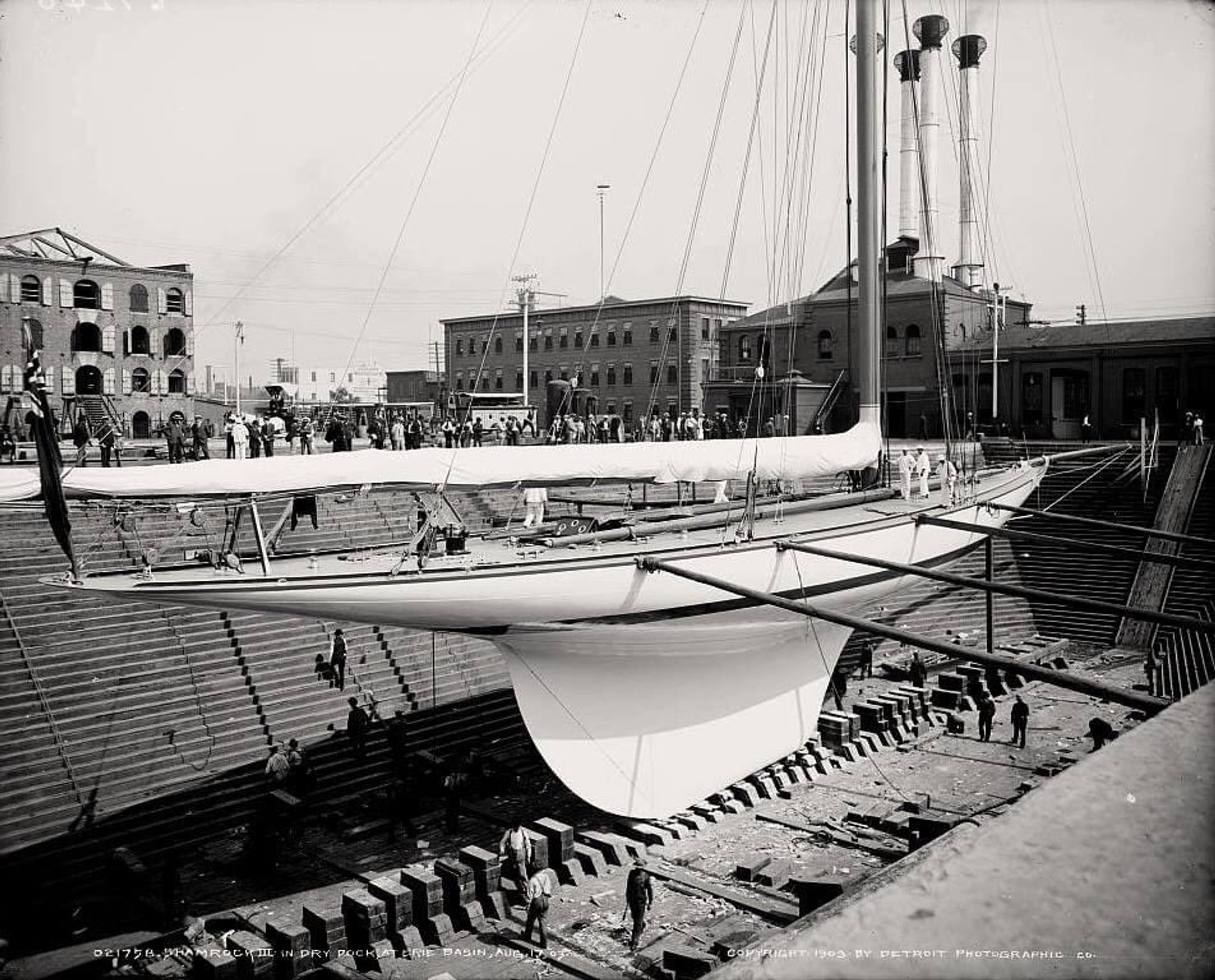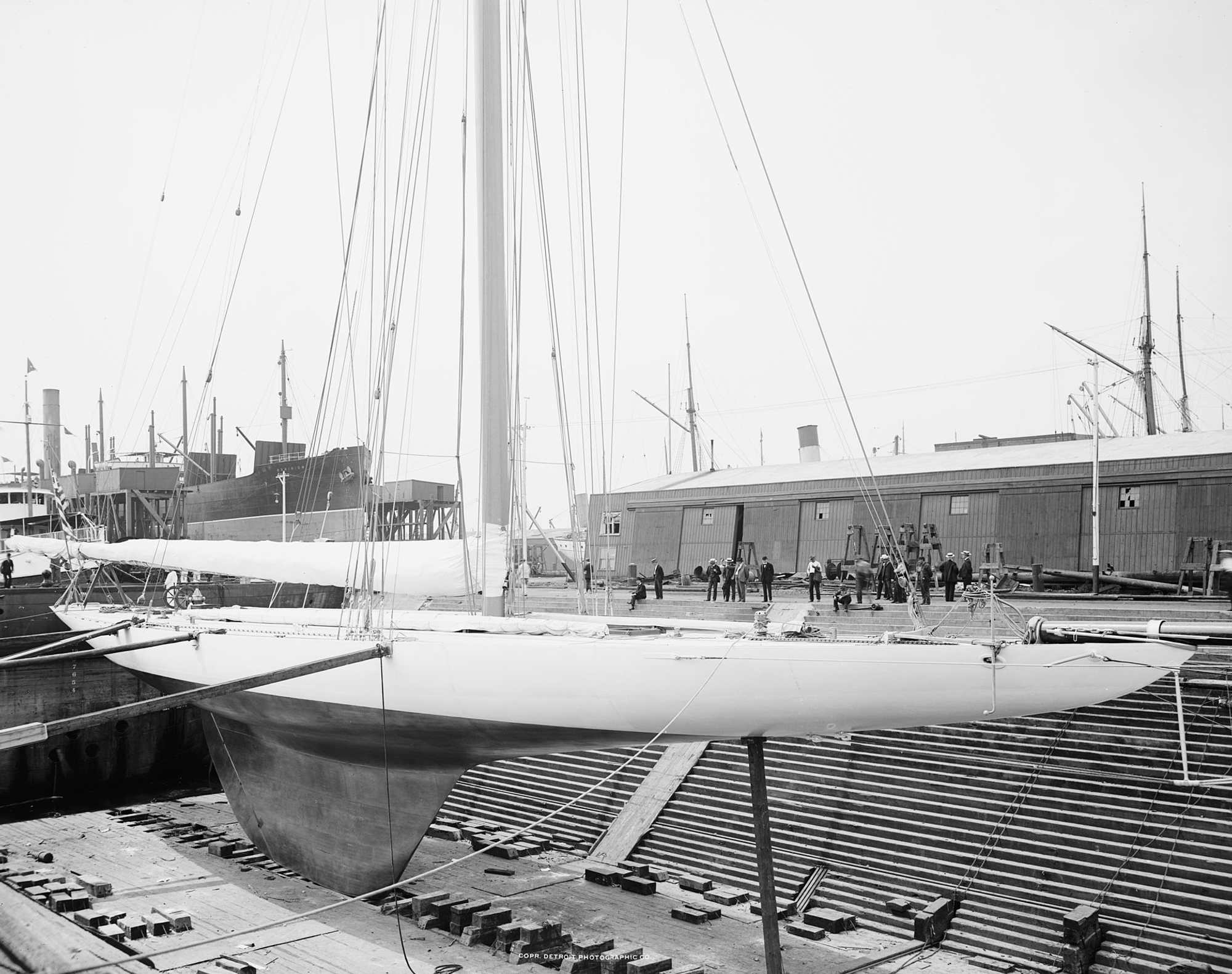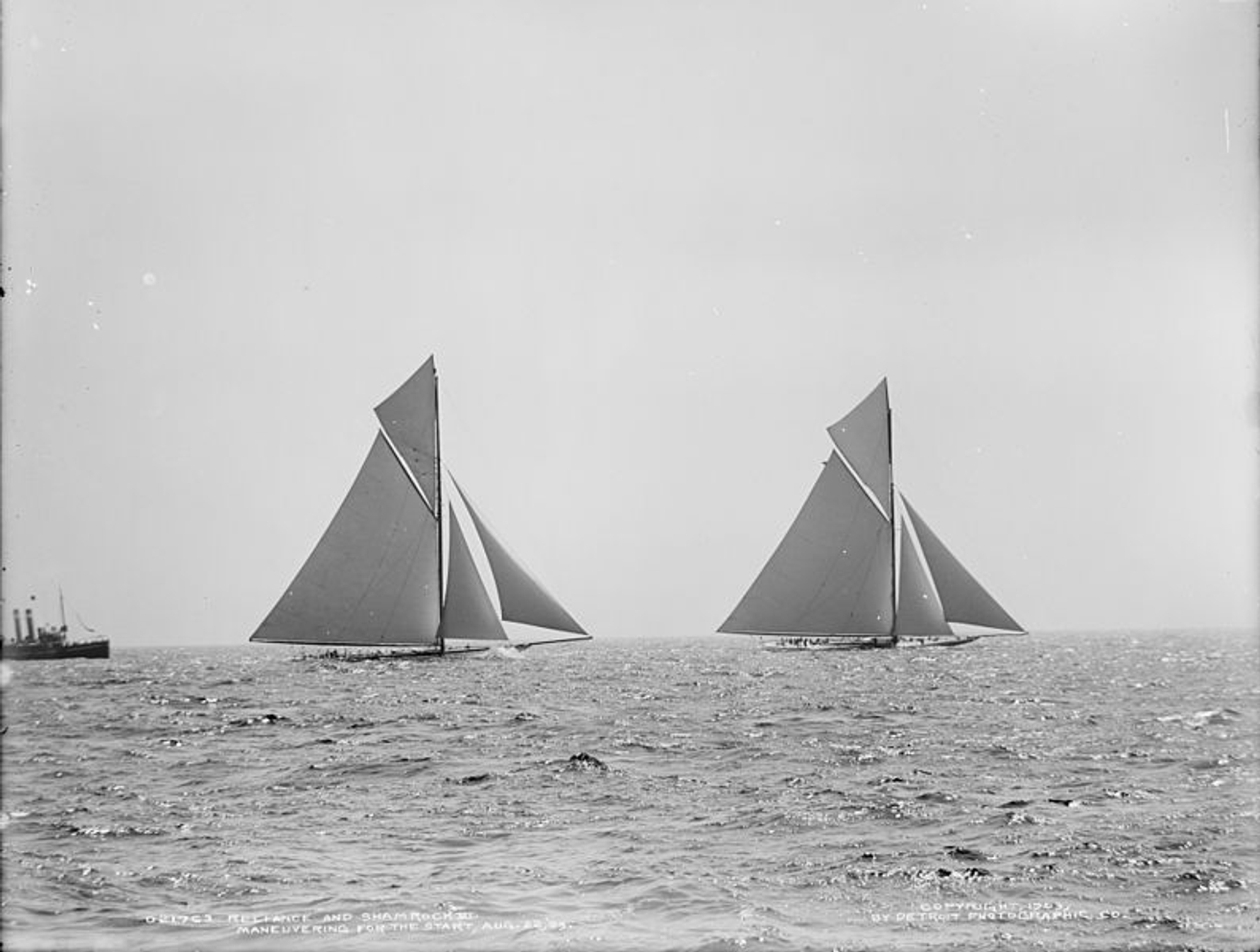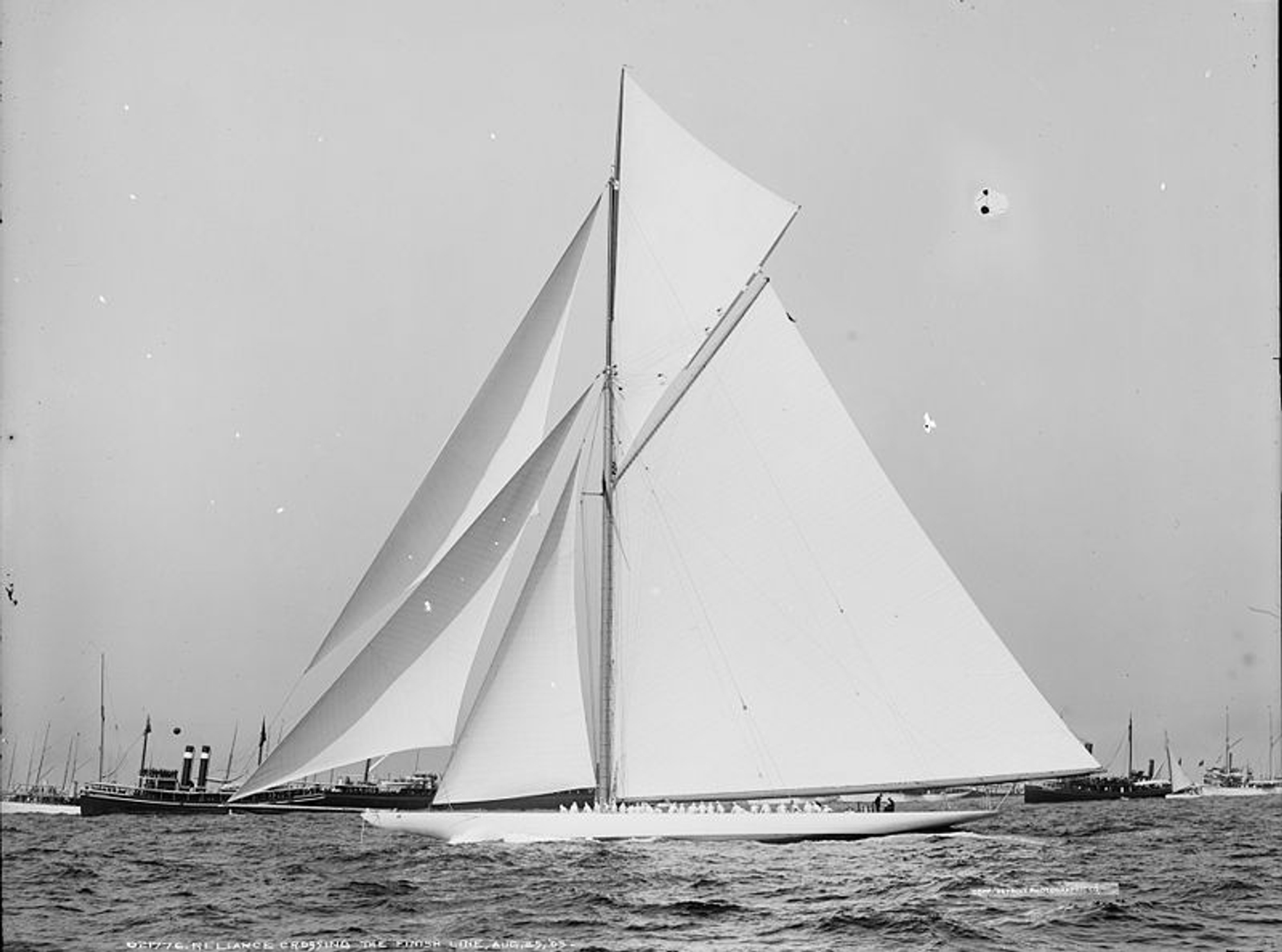LIPTON’S THIRD CHALLENGE
With Shamrock II laid up in Newport in 1901 after a request from the Royal Ulster Yacht Club for a re-match for the America’s Cup the following year to the New York Yacht Club was declined, Sir Thomas Lipton returned to Scotland and immediately set about laying the foundations for his third challenge.
After analysis of the design deficiency and overall management of his 1901 effort, a new direction was required and quickly the services of William Fife were engaged but crucially, Lipton managed to bring G.L Watson into the frame in a consultative role with the two leading designers working collaboratively together. Watson held the tank-testing results conducted at the Denny facility in Dumbarton and line drawings that had resulted in Shamrock II and these were shared with Fife in the hope of giving him a distinct advantage in the design of what would become Shamrock III.
Watson was more than accommodative and offered a thorough design analysis to the lead designer and agreed to play a role in further tank-testing as well as advising on construction – most notably his insistence on aluminium decks set on a steel hull. Meanwhile the Royal Ulster Yacht Club and Lipton himself were in considerable dialogue with the New York Yacht Club about the class of boat as it had been rumoured that the Americans were looking at making alteration to the club’s measurement rule which could have the consequence of changing the nature of the races for the America’s Cup itself.
Commodore Cass Leyland of the NYYC was rumoured to be the instigator of the changes seeking a “more satisfactory and wholesome type of vessel than has been produced under the current rule,” but in correspondence with Lipton, confirmed that these ideas were at an early stage and would not be implemented for a challenge in the following year, 1903, should it arise. On October 7th, 1902, a formal challenge was issued on behalf of Sir Thomas Lipton by Hugh Kelly, the Honorary Secretary of the Royal Ulster Yacht Club for a new vessel, Shamrock III, with a length at waterline of 90 feet. It was the start of the most expensive Cup challenge in history.

As the Americans became aware of Lipton’s third challenge and his likely ‘win at all costs’ approach, C. Oliver Iselin was keen to not only meet fire with fire but to secure the very best crew capable of defending the America’s Cup. Having effectively outsailed Shamrock II and with better preparation clearly a deciding factor in that victory, Iselin’s first move was to secure the services of Captain Charles Barr before courting the skills of the ‘Wizard of Bristol’ Nathaniel Herreshoff who had been reluctant to join the nascent syndicate.
Herreshoff was a man concerned for the future of his burgeoning business and considerable reputation that he had built up and liked to be a master of his own destiny. In the 1901 defence, a restrictive covenant had precluded him from building the sails for Columbia, a job undertaken by Thomas Ratsey of Cowes who had set up a loft in New York, whilst on the design front he was concerned by the rising reputation of fast coming designer Starling Burgess and the skill of Boudoin Crowninshield (designer of Independence).
However, Oliver Iselin was persistent, and a considerable war-chest was afforded by Commodore Ledyard, bankrolled by significant millionaire members of the NYYC and with a reported $300,000 budget, the Herreshoff Manufacturing Company signed on the dotted line in September 1902 to build what was to become ‘Reliance’ – one of the grandest yachts ever built for the America’s Cup. In mentioning the millionaire backers of the Ledyard syndicate, it’s important to note that these were the new wave of oil barons, railway entrepreneurs, industrialists and scions of the burgeoning banking scene in New York whose mantra was ‘bigger is better.’ It was a time of mass expansion, and the expression of this wealth could be seen most notably in the changing face of the New York skyline and the weekend houses of the Hamptons and all around Rhode Island. Herreshoff as a result, was given a free hand and a mandate to build not only the fastest boat to defend the Cup, but the biggest too.
The cost of competing, on both sides, was of little concern. Sir Thomas Lipton had green-lighted the expense of £10,000 worth of aluminium for the decks of Shamrock III whilst Herreshoff deemed that Tobin bronze was the ultimate construction material for Reliance. When the lead was poured for Shamrock III, run through the lower part of the steel frames in the midship section (a construction method that allowed for lighter frames), Lipton expressed confidence in the duo of Fife and Watson saying: “They don’t care a cent about money, and they love the profession as much as Herreshoff.” Supporting the Challenger was the considerable workforce and facilities of the Denny’s Yard in Dumbarton with its 2500 strong labour force and tow-testing facilities, so it was scant surprise that the boat was finished early and launched on March 17th 1902, St Patrick’s Day, into the River Leven having been christened by the Countess of Shaftsbury, the wife of the Commodore of the Royal Ulster Yacht Club. Reliance was coming along at pace too in Bristol, Rhode Island, but without needing to cross the Atlantic on her hull, patience and care could be applied whilst a shroud of secrecy enveloped the build. She was duly launched on April 11th, 1902, and christened by Oliver Iselin’s daughter, Nora.

As is so often in the America’s Cup, even to this day, the respective launches of Reliance and Shamrock III revealed innovative hull shapes but hid the real advances going on below decks in mechanical and structural engineering. Reliance drew gasps at launch for her long overhangs, but it was under the decks where Herreshoff had installed advanced (for the time) two-speed winches to carry the vast loads of the mainsheet, jib sheets and halyards where the real efficiency lay. Further advances were later revealed when an innovative Herreshoff design for the rudder allowed water to be pumped in and out of the hollow blade using a pneumatic pump according to the conditions and how heavy the boat was on the helm.

Meanwhile, Shamrock III had employed the use of American-made blocks for the rig and a mainsheet that had a steel core whilst having the aforementioned lightweight construction of her inner frame. She was also the first challenging yacht to feature wheel steering – a considerable departure from the accepted wisdom of tiller steering for the British. Technology was coming to the fore, like never before, in the America’s Cup.
After launch, Reliance was put to the test almost immediately with a long summer of racing scheduled against two of the fastest trial horses in Constitution and Columbia, both with a proven pedigree and fantastic racing record. Reliance was a sensation that summer and almost unbeatable on a windward-leeward course in virtually all conditions. The rising star of yacht design, W. Starling Burgess wrote in the Boston Herald that: “The Reliance is distinctly a fin scow though of fair and moderate proportions. The chief characteristic is enormous sail carrying power. Although from time-to-time phenomenal boats have appeared, which, through sail or light power, develop much speed, it is a general rule that where sail is not too heavily taxed, the greater spread the boat can be shaped to carry, the greater will be her speed. From the Puritan to the Reliance, each successive Cup defender has shown an increase in sail area far more than proportional to any added waterline length she may have had. The Reliance’s great gain in power over the Columbia and the Constitution has been afforded not by increased weight of keel nor light construction of hull, but by the use of the scow form…The Reliance’s beam on deck is but slightly in excess of her waterline beam, so that her sides are nearly plum in great contrast to the flaring sides of the Shamrock III.”
In a total of 21 races sailed that summer in trials, with 19 completed between the three boats, Reliance won 16 with Constitution winning the other three and Columbia, previously a generation-ahead vessel and Cup winner just two years previously, failing to register a win. Reliance was duly selected after a committee meeting at the NYYC on the evening of July 27th, 1903.
Shamrock III and Reliance were towed to Eerie Basin, as was custom, for measurement and inspection ahead of the first race scheduled for August 20th, 1903, and for the first time the significant differences were laid bare. Whilst the overhangs on the American yacht were the most obvious difference, when measured, the sail area on Reliance was 1,832 square feet more than Shamrock III whilst her main boom at 115ft in length was 11ft longer. The gaff on Reliance was 9ft longer too, at 71.9ft and after calculation the Americans gave the Challenger some 1 minute 45 seconds on corrected time that was further adjusted to 1 minute 57 seconds after a final change to the height of the throat halyard block on Shamrock III. It was the biggest corrected time handicap in America’s Cup history.
The morning of the first race on August 20th, 1903, was dogged by light winds with both boats being towed out to the racecourse ahead of the 11am warning signal for the 30 mile windward-leeward course. With Captain Bob Wringe on the wheel of Shamrock III, the Challenger crossed first with the Defender some 33 seconds adrift. It was not to be however as a duff tack left Shamrock III dead in the water and Captain Charles Barr glided by to seize a lead in desperately light conditions that he would not relinquish. The beat to the windward mark however, took some four and a half hours and with the time-limit looming and Shamrock III far astern, she retired and the race was subsequently abandoned.
The next time the boats came together was on August 24th, 1903, two days after a race organised by the NYYC that celebrated the first win of the America and the 52nd anniversary of that great victory in Cowes, that Shamrock III competed in. Her crew were dialled in to the conditions and Wringe was first to cross the line, steering Shamrock III through the lumpy seas seemingly better than Barr. But the Americans sought flatter water by the New Jersey shoreline and very quickly her pointing ability combined with her sheer power induced by the enormous sail plan came to the fore. By the windward mark Reliance was 3 minutes 17 seconds ahead and after a masterful run to the finish, had extended to some 9 minutes on elapsed time and 7 minutes 3 seconds on corrected. One nil to the Defender. Lipton who had been sitting on his steamer, Erin, commented: "Reliance deserved the victory. But I expect Shamrock to do better under different conditions. I shall start in Tuesday morning just as confident as I did today."
Sir Thomas Lipton could most probably see the writing on the wall already but was cajoling his team to do better through the media. A new mainsail was delivered by Thomas Ratsey’s New York loft with a flatter cut to aid pointing ability, lead was removed from the keel and Shamrock III was back into the Eerie Basin for re-measurement. The differences were minimal, and the time difference stood unchanged.

When the boats came together again for race two on August 25th, 1903, it was a frustrating watch for Lipton again as his helmsman Bob Wringe was wrapped up in knots in the pre-start by Charles Barr and crossed the line 19 seconds after the second gun handing a huge half-mile lead to Reliance. On a triangular course set from Sandy Hook lighthouse in a steady 7 knot breeze and flat water it was expected that the Americans would walk away with the race but Shamrock III clung on, sailing flawlessly, footing beautifully in the conditions whilst Reliance pinched and stalled, and it was a surprise to the spectator fleet watching that by the first windward mark she was only 49 seconds to the good. After a slick hoist of her spinnaker right on the mark and some powerful sailing to the wing marker, Reliance gained a further 1 minute 23 seconds and on the shy reach to the finish with balloon-top jib set and her vast sail plan pulled the Americans a further 45 seconds to the good. The final result showed Reliance winning by 3 minutes 16 seconds on elapsed time and 1 minute 19 seconds on corrected. A credible performance from the Challenger but simply not enough.
To say that Bob Wringe was a beaten man, was perhaps an understatement and the next few attempts at races were to prove as much a mental battle as a sailing one. In the abandoned race three, Barr again out-manoeuvred Wringe forcing him to come over the line some 1 minute 42 seconds after the second gun and watched as Reliance sailed off into a 12-minute lead before mercifully the racing was stopped due to the time-limit. In a subsequent race, again abandoned, Reliance held a lead of 20 minutes before the time-limit was achieved so by September 3rd, 1903, the day of what was to prove to be the final race of the America’s Cup, hopes were not high for the Challenger.
The dawn of September 3rd, 1903, again saw a light-weather forecast, the remnant of a blustery front that had blown across the racecourse the previous weekend and had left the boats in harbour at anchor. In the aftermath of the storm, a further two days were lost so it wasn’t until the Thursday that week that the race got underway at 1pm after a lengthy day by the very patient race committee. The crew of Shamrock III, burned by the recent performance of Reliance and in particular its hard driving skipper Charles Barr, eschewed the pre-start manoeuvres and opted for a run-and-hide strategy. The tactic left the door wide open for Reliance and on the trail in, she crossed 4 seconds after the second gun with Shamrock III a further 11 seconds behind that cut down her time allowance by seven seconds.

In the light four to seven knot breeze, Reliance’s sailplan was the ace in the pack. Barr close-covered Wringe up the first beat with the aggressive covering being later described as a “headlock from which The Shamrock could not escape,” and by the windward mark, the Americans were an astonishing 11 minutes up. The 15-mile run to the finish was notable for the wind shifting forward and for the fog rolling in making navigation tricky and forcing the race committee to shorten the finish line to the lighthouse as they had lost visibility and were relying on the hoarse siren to locate the marker. Reliance picked up speed and breeze and with expert navigation thundered through the gloom at 12 knots and secured the defence of the America’s Cup. As a perhaps fitting but somewhat despondent end to the Lipton challenge, Shamrock III missed the lighthouse and committee tug and thus scored a DNF.
For Sir Thomas Lipton it was a crushing defeat and brought to an end an era that over three challenges had cost him in the region of three million dollars – an astronomic sum at the time. But he left with good grace and was a popular addition to New York high society throughout his time in America. He said afterwards: “What can I do? I have tried my best. I cannot design a boat; I cannot sail one. I have common sense and I can see that Reliance is the better boat. If I could design the challenger, then sail her, I might not be so blue as today. There is no denying that I am sad and discouraged.”
Lipton’s lament was certainly not the last in the history of challenges for the oldest international trophy in sports and Lipton was certainly not done with the America’s Cup. Far from discouraged, the enigmatic tea baron would be back…